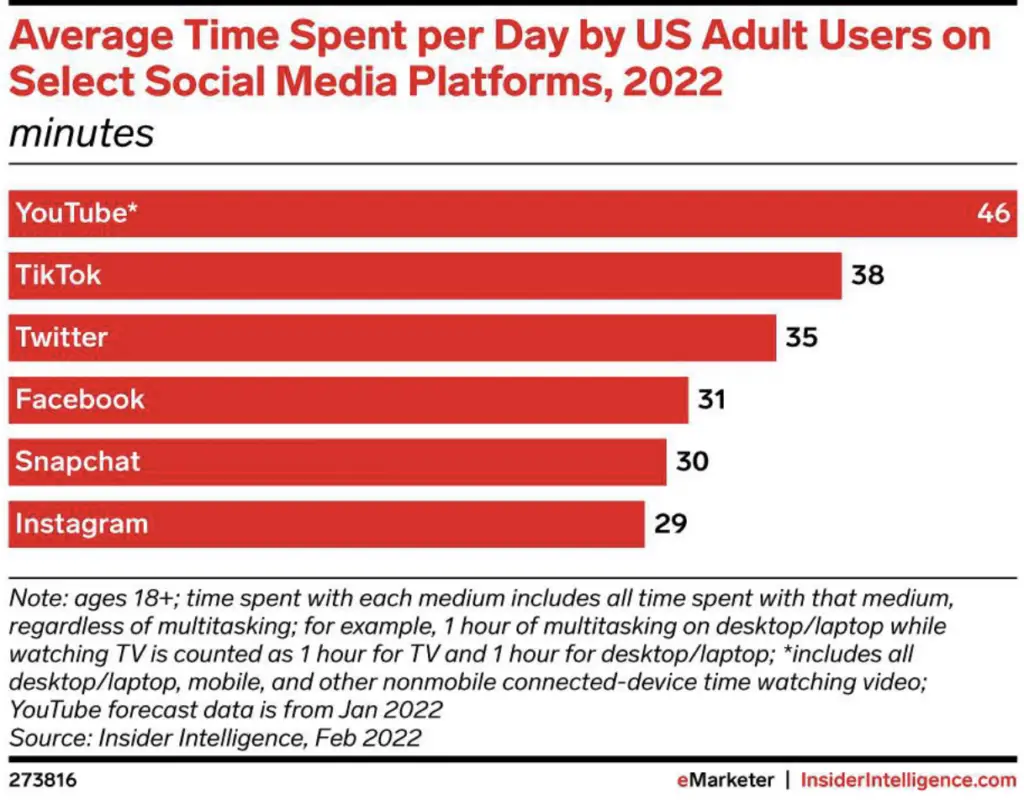
15 Jul A Look at TikTok Commerce in 2022
It’s no secret that the emergence of TikTok has changed the traditional social channel landscape regarding entertainment. According to eMarketer, US TikTok Adult users spend an average of 38 minutes/day on the platform. When compared to other traditional social networks like Twitter (35 minutes/day), Facebook (31 minutes/day), Snapchat (30 minutes/day), and Instagram (29 minutes/day), TikTok has the lead.

You’re already seeing competitors like Facebook and Instagram adjusting their app experience to include “For You feed” lookalikes by adding Facebook and Instagram Reels. While TikTok has encouraged its creators to be the driving force of the platform by developing entertaining and engaging content, the company looks to improve its commerce experience.
According to eMarketer, 24.8% of TikTok users are inspired to purchase when they use the app, but only 15.0% of users make a direct purchase. Compared to other social channels like Facebook, the social giant reigns supreme, with a staggering 67.7% of users are inspired to make a purchase and 74.2% of users making a direct purchase on the platform. Though TikTok users are highly engaged and spend dedicated time on the platform, it doesn’t have the largest shopper base. But this year, it’s working towards improving the overall experience for both users and brands or advertisers.
What TikTok Commerce Looks Like in 2022
In March of this year, eMarketer hosted a TikTok Commerce 2022: Strategies for Success webinar. Early in the presentation, it highlighted the apps’ rapid growth and success due to its priority on content creation and its creators. However, TikTok is looking to improve its social commerce experience. It’s important to note that there are already “areas” where users on TikTok can purchase products. They are:

- In-App Storefronts: US Merchants can add a tab to their profiles to create a mini storefront. Clicking on a product sends users to a merchant’s site to complete the purchase.
- Product Links: Users who click on a Product Link will be directed to the merchant’s storefront to complete the purchase. Like product tags on Instagram or affiliate marketing links.
- Collection Ads: Businesses can upload a product card to in-feed ads. Users who click on an item in a card will be shown a swipeable instant gallery page through which they can browse and buy items.
- Dynamics Showcase Ads: Merchants can integrate their product catalogs into these personalized ads served to users based on their interests and activity.
- LIVE Shopping: Businesses can now integrate their product catalogs from TikTok Shopping through dynamic links during a Livestream.
By utilizing TikTok in-app shopping capabilities, it makes it a simple and shorter path-to-purchase for users. For more information on TikTok Shopping,
Content-First, Commerce-Second Approach
On a content-driven platform like TikTok, it’s important to keep in mind that users open the app to be entertained. During the webinar, the speakers introduced the “3 Cs” to follow when creating a Content-First strategy.
The 3 Cs are as follows:
- Communities: Communities are a niche group of TikTok users who share a common interest. Find your niche and then find your niche within it.
- Creators: TikTok is full of “everyday influencers.” This means you don’t need to work with a creator who has millions of viewers. TikTok users tend to follow and view content from niche influencers (who are more often viewed as peers).
- Connection: Though many factors weigh into a purchasing decision (i.e., price, quality of a product/service, customer service, etc.) what resonates with TikTok users when shopping on TikTok is authenticity and transparency. These two characteristics are key to forming a connection.

Best Practices When Leading with a Content-First Approach
When you’re trying to attract and engage an audience, putting content first is always the right move. But what are the best practices for doing this? And how can you make sure that your content-first approach leads to success? Here are a few of them.
- Don’t be overly promotional – TikTok claims that most of the best-performing video contains content that is unrelated to the product, but brands feature it in a native and nonpromotional way.
- Don’t be afraid to poke fun – TikTok users resonate well with cheery, bold, and tongue-in-cheek humor.
- Incorporate sound – TikTok noted that most viral content on the platform uses audio clips with original audio, trending sounds, or popular songs.
- Give creators creative freedom – More times than not, creators understand how to best present products in a native and entertaining way.
- Entertaining can also be educational – Some of the most-watched videos on TikTok are life hacks, tips, and tricks.
- Choose your product wisely – One of the many benefits of a content-first platform is viral unpredictability. However, TikTok mentions that exclusive or limited-edition products have higher predictability.
For creative ideas, check out a few examples from another Ignite Social Media blog post here.
Final Thoughts
There was plenty to unpack above so here are the key takeaways when it comes to TikTok Commerce:
- Integrate TikTok’s shopping capabilities to maximize opportunity.
- Take a Content-First, Commerce-Second strategy approach.
- Utilize creators for TikTok Shopping.
If you’re ready to take that next step and elevate your TikTok presence, contact our team of experts today. Additionally, keep yourself up to date on the latest news and trends in social media by subscribing to our e-newsletter, Social You Should Know, below.






